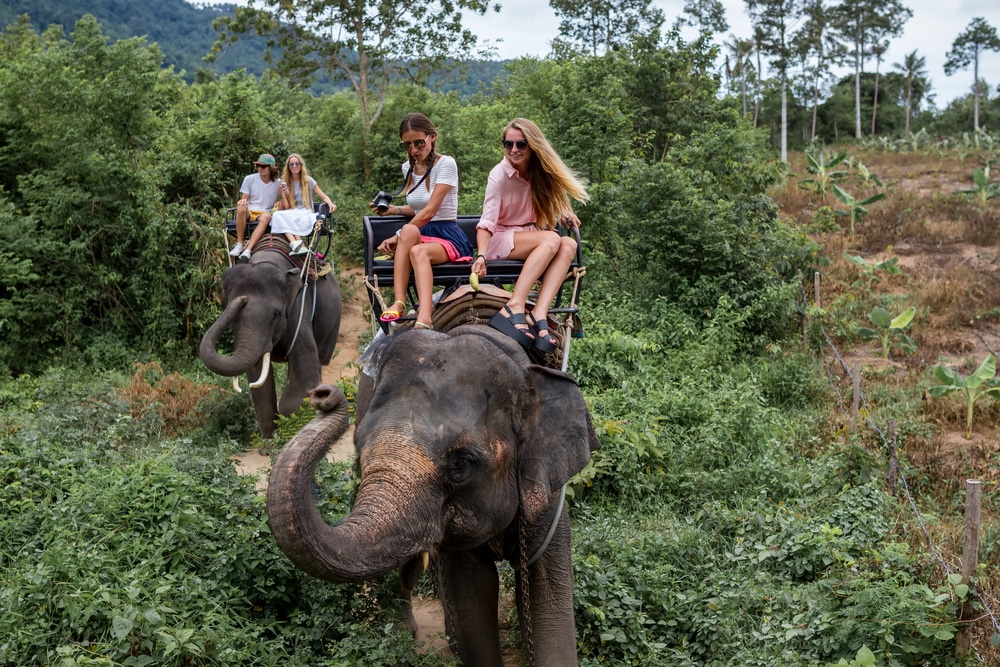
Riding elephants, taking a selfie with a sloth or petting a tiger. Those who go on long-distance trips in particular often come across tourist offers in which wild animals play the main role. But does animal welfare fall by the wayside? The World Animal Welfare Society gives travellers tips on which offers should be avoided in the interests of animals and shows possibilities for animal-friendly wildlife tourism.
A central rule is: Please no direct contact with wild animals! It should always be remembered that wild animals are not dogs or cats that have been domesticated for generations and are used to contact with humans. Any human-wildlife contact can change the natural behaviour of the animals, stress them out or make them more likely to fall victim to poachers later on due to their lower shyness. Exceptions for close contact with wild animals only apply in special situations, for example when injured wild animals have to be picked up and then cared for.
Travelers should be aware that many animals offered as “attractions” have a long history of suffering behind them. Because the problem can already start with procurement. Often the animals – for example monkeys – are caught as babies and snatched from their mothers, who are usually killed by poachers in the process.
Animal suffering is behind many offers

Nevertheless, many providers take advantage of travelers’ desire to see wild animals up close or even touch them. Two offers in the field of wildlife tourism exemplify the underlying problems.
A well-known example is so-called otter cafes, which are very popular in Japan. Tourists have the opportunity to pet dwarf otters there, and then often post photos and videos of them on social networks. But there is a high probability that massive animal suffering is hidden behind these animal encounters: both in the procurement – the otters may have been snatched from the wild and traded illegally just for this purpose – and in the cafés themselves, where they cannot escape the animals from the situation and direct contact with humans is unavoidable.
Offers to ride wild animals such as elephants are also highly problematic. After all, how is the wild animal made to accept such close and protracted contact with constantly changing people? The fact that this requires the use of force in elephants is known from many examples. In addition, it is usually not clear to travelers how the animals are kept outside of their working hours and what professional background their caregivers have.
A lack of knowledge regarding the above-mentioned, unfortunately very popular offers with animals harbors many dangers. This is because any direct contact with wild animals can be extremely harmful to the animals.
The consequences of wildlife selfies
Another factor that is dangerous for animal welfare is the uncritical presentation of wild animal photos on social networks. If tourists post posts such as selfies with wild animals, this can immediately increase the demand for such offers. So anyone who sees pictures and videos of close contact between humans and wild animals should not show any reaction – for example through comments or emojis – but consistently report the content to the networks’ moderator teams. In addition, it can be food for thought to point out to the creators via private message what further animal suffering the uncritical presentation could result.
Further information on the topic of “Animal suffering in social networks” is available on the website of the World Animal Welfare Society:
https://welttierschutz.org/stoppt-tierleid/
The World Animal Welfare Society contrasts the numerous critical points with a list of how animal-friendly wildlife tourism can work and how travellers can recognise corresponding offers:
- The highest priority should be to perceive wild animals as natural wild animals. This also means that this information is already clearly highlighted in the offer.
- Wild animals living in nature as well as wild animals, for example in conservation centres, should only ever be observed and photographed from a distance. Direct contact, especially touching, feeding and petting, must not be permitted.
- Tours of facilities such as shelters should only be offered in small groups and should always be led by staff.
- The commandment should always be calm and not actively seek contact with the animals.
- When touring within the habitat of wild animals, care should be taken not to leave any rubbish behind.
The animal welfare activists advise always finding out in advance about the destination and the nature and wildlife there. As soon as doubts arise about the activities offered, it is essential to ask the provider. If this does not sufficiently ensure that the offer is animal-friendly, it is in the interest of the animals not to take advantage of the offer. Anyone who observes grievances during an offer even after careful examination should talk directly to the provider and fellow travelers about it. A tip to local animal welfare associations can also help, because they know the local conditions and can still advocate for the welfare of the animals vis-à-vis authorities and other bodies even after the travelers have long since left the country.

